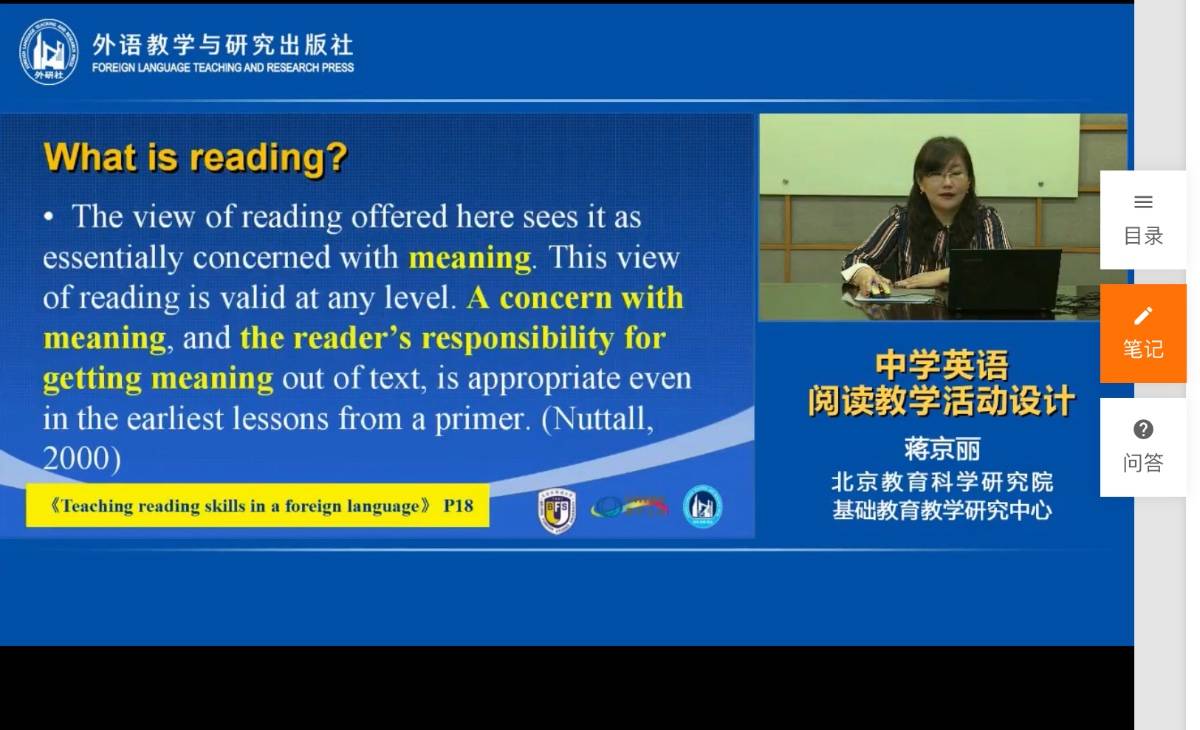1. 12个对阅读的观点,是否正确?
2. 什么是阅读?
不同学者对于阅读的定义:已有知识与阅读文本的交互性
3. 什么是阅读教学?
阅读教学不同于阅读,阅读教学需将阅读内容+语言教学结合,由表层文本
1. 12个对阅读的观点,是否正确?
2. 什么是阅读?
不同学者对于阅读的定义:已有知识与阅读文本的交互性
3. 什么是阅读教学?
阅读教学不同于阅读,阅读教学需将阅读内容+语言教学结合,由表层文本
阅读的层次-1
读懂 读细 读深 读活
读懂 读细-学习者对文本的认知 理解和欣赏阶段
读深 读活-学习者对文本的评价和创造阶段
通过12个常见的问题引发不同的老师对于什么是阅读的思考和解答了蒋老师心中真正的阅读定义。
蒋老师通过各个时期的专家对于阅读的定义更深层次解析了阅读和阅读活动。
阅读教学是出于教学目的让学生做的阅读。
阅读的层次1:读懂、读细、读深、读活
阅读的层次2:第一层检视性阅读,学习者通过阅读掌握文本的主题意思
第二层,快读和略读,学习者根据不同的阅读目的,有意识地对信息材料做取舍,实现有效的阅读。
第三层,概括与归纳性阅读,学习者对信息材料进行分析和研究,做出宏观或微观推理。
第四层,批判式阅读,学习者结合自己的知识,对文本提出自己批判性的分析意见。
阅读层次3 Read/Understand the lines
Read/Understand between the lines.
Read/Understand t
意群
打断学生的思维
不要总翻译
默读可以帮助思考,带有目的去阅读会更有效,阅读是个体的行为,缺乏文化背景知识会影响阅读。
大量参与阅读
阅读不是只有一个目的,阅读时,有效提升阅读速度和策略,应该是意群为单位去理解文章。目的决定速度。翻译成中文不能有效帮助理解文章,不可每遇到一个次都去查字典,会影响思路。拥有大量的词汇量对comprehension有好处,但不绝对。
what is reading?
阅读是动态的、解决问题的过程
阅读是获取信息的过程,也是解释信息的过程
积极主动的认知过程,强调读者与文本间互相作用
思想与语言之间相互作用的心理语言猜测过程
作为不断做出假设的动态过程,是心理语言猜测游戏
阅读教学
是出于教学目的让学生做阅读。
要把英语阅读的现实功能与教学功能结合起来
(现实功能:通过阅读增长知识、丰富经验和情感、加深对世界和自己的认识、体验语言文学之美;教学功能:扩大语言输入、感知语言的使用、学习语言知识、训练英语阅读技能)
阅读的层次-1
读懂
读细 (认知、理解、欣赏)
读深
读活 (评价和创造)
2
检视性阅读
快读和略读
概括与归纳性阅读
批判式阅读
3
read/understand the lines
read/understand between the lines
read/understand beyond the lines
默读帮助思考获取信息,朗读提高语音语调。阅读目的阅读速度不同。阅读是个体行为,缺乏文化背景知识影响阅读能力,大量阅读有帮助。阅读的目的很多。以意群为组,读。不必查所有的生词。词汇量是必要的,还需要有语言背景知识。
What is reading?三层次表--l
read understand the lines,between the lines,beyond the lines
中学英语--阅读教学活动设计
第一部分:阅读
1. Do you agree or disagree?(ask students about sth.)
2. reading with a purpose& silent reading& background information& with different speed (purpose determine the speed)
中学英语阅读教学活动设计
首先,清楚阅读
对于默读,可以帮助我们思考和信息,带有目的去阅读,会更加有效;阅读是一个个体的活动,缺乏文化背景知识有碍阅读水平提升;阅读应以群为单位,目的决定阅读速度;
阅读教学是出于教学目 的让学生做的阅读。
阅读层次1 读懂,读细,读深,读活
2 检测性阅读 快读和略读 概括与归纳性阅读 批判性阅读
3 理解表层文字 推理判断内涵 更高阶的思维加工
① read with purposes
② back knowledge of culture
③ vocabulary + topic + culture
④ what is reading:
A: Thorndike(1917):reading is an active process related to problem solving
B: W idson(1979):阅读不仅是获取信息的过程,而且是解释信息的过程。
c:阅读作为积极的认知过程,强调读者与文本间互相作用的重要性。
D: Goodman(1967)阅读是一个思想与语言之间相互作用的心理语言猜测过程(a psycholinguistic guessing game丿
E: Nuttal(2000)阅读作为一个不断做出假设的动态过程是一个心理语言猜测游戏。(《teaching reading skills in a foreign language>>p 18: the view of reading offered here sees it as essentially concerned with meaning. This view of reading is valid at any level. A concern with meaning and the readers' responsibility for getting meaning out of text, is appropriate even in the earliest lessons from a primer. (Nuttall, 2000丿
F: 《planning a lesson for a reading class 》Pi
Reading is the process of constructing meaning through the dynamic interactionamong the reader's existing knowledge, the information suggested by the written language. And the context. (Anthony, person,&Raphael, 1993. )
 Reading is an active process related to solving problem
Reading is an active process related to solving problem
Reading is not only a process of getting information but also a process of explaining information
With the existing knowledge,
阅读层次:
层次一
1读懂、读细、读深、读活
(1)读懂、读细——学习者对文本的认知/理解和欣赏阶段
(2)读深、读活——学习者对文本的评价和创造阶段
层次二
检视性阅读
快读和略读
概括与归纳性阅读
批判式阅读
层次三
Read/understand the lines
Read/understand between
Read/understand
阅读概念:
阅读是做出假设,心理猜测游戏。
阅读是对于意义的关注、探索、建构。
阅读步骤:
step1: search for main idea
step2: skimming for Q & A
Step3: sumary/analysis
Step 4: Comments
阅读步骤:3 levers:
read and understand the lines
read and understand between the lines
read and understand beyond the lines